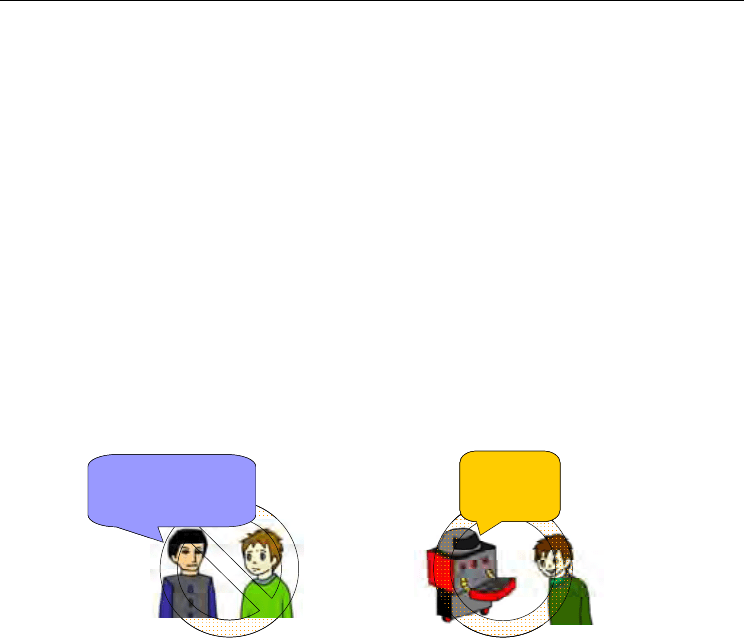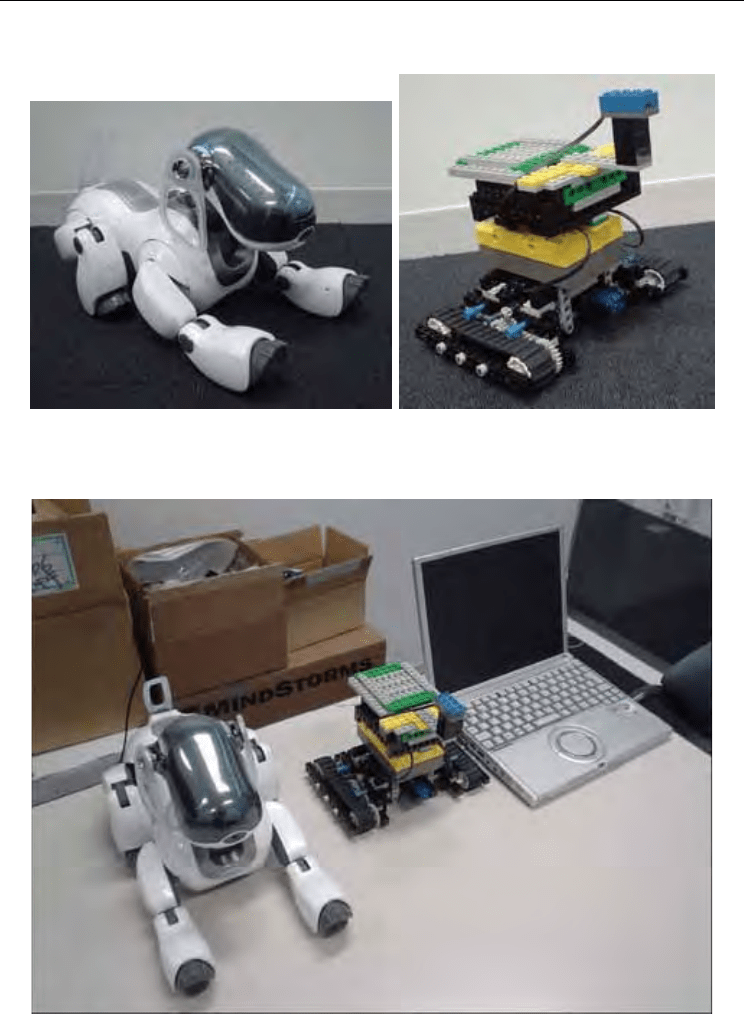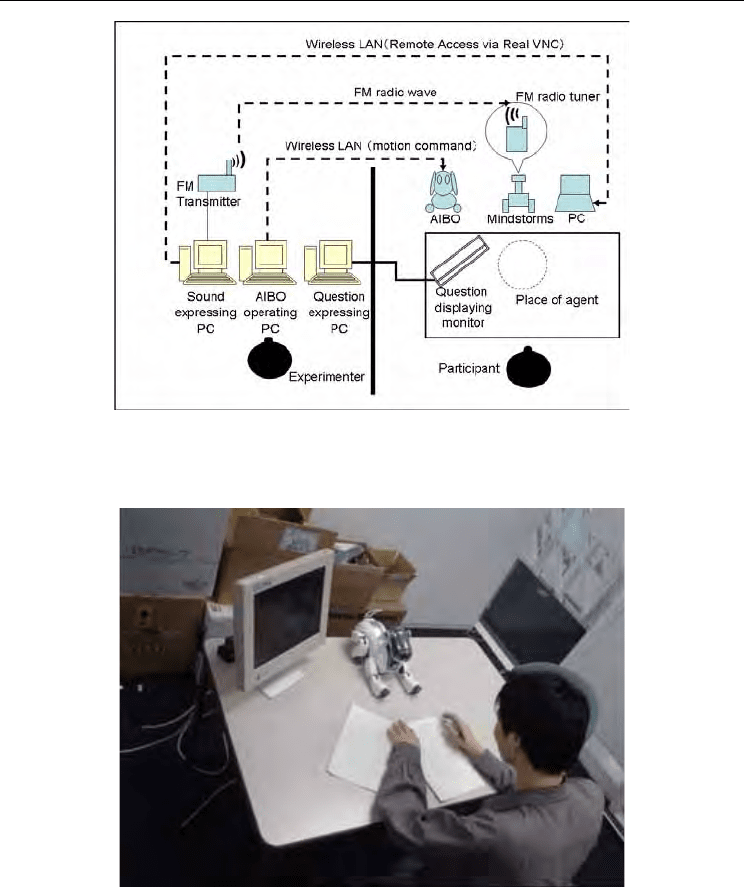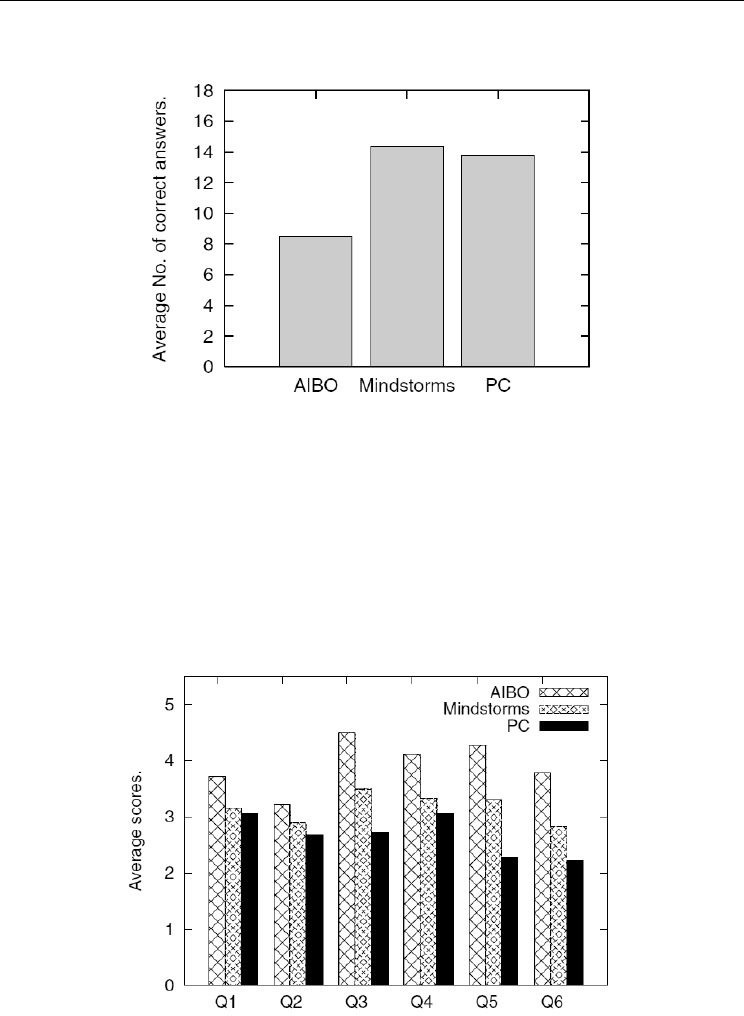Sarkar N. (ed.) Human-Robot Interaction
Подождите немного. Документ загружается.

27
Designing Simple and Effective Expression of
Robot’s Primitive Minds to a Human
Seiji Yamada
1
and Takanori Komatsu
2
1
National Institute of Informatics,
2
Future University-Hakodate
Japan
1. Introduction
In recent years, home robots and entertainment robots like Roomba, AIBO have started to
move out of laboratories and in people’s homes. Almost all of them are for entertainment
use to a user and the remaining ones are for a simple home task like rough sweeping by
themselves. However home robots for a home task are expected to spread out in our dairy
life rapidly because there are strong needs for the robots to be able to achieve various home
tasks like sweeping, cooking, washing up, clearance and so on. In this situation, since a
robot often cannot achieve such a task by itself, it needs to ask a user help it’s task. For
example, even though sweeping is a very simple home task, a robot can not remove a heavy
or complicatedly structured obstacle like a chair, a table or a cart in order to sweep the floor
under it. In this case, a robot should ask user helping behaviors to remove these obstacles .
The significant problem here is how to express the robot’s internal state to a user. We call
such an internal state the robot’s mind because it may correspond to a human state of mind in
the theory of mind (Baron-Cohen, 1995). We consider that these expressions should be
designed depending on the robot’s appearance because the appearance of the robots would
significantly influences human impressions and interpretations of robot’s expressions.
Although it is an important problem to design how a robot expresses and informs its mind
to a human depending on the appearance, few studies on designing robot’s expression in
such a way have been done thus far. In general, one of the simplest ways to express the
mind is to use verbal communication with speech synthesis and it may be independent of a
robot’s appearance. However, in these days, such verbal communication significantly
depends on the processing quality of natural language, and unfortunately, this quality is not
mature for the actual use for our purpose. Hence we focused on nonverbal communication
because various psychological researches showed that nonverbal communication also
contain rich information than verbal ones.
In this chapter, we propose a policy to design expressions of robot’s mind depending on its
appearance, called “SE4PM: Simple Expression for Primitive Minds.” According to this
policy, we would like to argue that a designer should design simple information with a
simple appearance to express primitive robot’s minds (Yamada & Komatsu, 2006). We
actually apply this SE4PM policy to express primitive minds of a robot with an appearance
of a simple mobile robot implemented with LEGO MindStorms, and design beep sound as
simple expression. We consider this beep sound is a promising way to express primitive

Human-Robot Interaction
482
minds like negative, positive, and neutral because it was reported to be effective in human-
computer interaction (Komatsu, 2006). To compare with our proposed expression, we
utilized a pet robot, AIBO, which has a complicated appearance and can express its
primitive minds by executing some complex behaviors with motion, light and sound. We
investigate the effectiveness of SE4PM policy by a psychological experiment to compare the
two robots. Finally we obtain results to support our SE4PM policy and find out it is a valid
policy to design expression of robot’s primitive minds depending on the appearance.
Different types of social robots have been developed to assist with various tasks in our daily
life (Morishima et al, 1995; Ishiguro et al, 2001). In general, these robots have a particular
appearance that is designed similar to that of humans or pet animals, i.e., beings that are
familiar to us. Most humans who interact with these robots notice the familiarity of their
appearances, and this makes it easier for them to communicate with these robots actively
(Breazeal & Velasquez, 1998). However, a robot’s appearance should not be the sole focus;
designing the robot’s expressed minds to enable better communication with users is also
important. Based on this concept, Ono and Imai (Ono & Imai, 2000) developed an interactive
robot that can express behaviors associated with frustration when it encounters certain
obstacles that interrupt its pathway.
On the relationship between a robot’s appearance and the function, Mori pioneered
relationship between an appearance and a movement in a robot with the uncanny valley
(Mori, 1970; 1982). His uncanny valley described a robot becomes more uncanny as it
becomes more similar to a real human. Although the uncanny valley does not directly imply
SE4PM, the basic consideration is close to it. We will discuss the relationship of the uncanny
valley and our SE4PM with feasibility, familiarity and implementability in terms of
engineering. Duffy also discussed anthropomorphism of a robot with much insight (Duffy,
2003), and he pointed out various important issues on relationship between
anthropomorphism and a robot. In contrast with their studies, we propose the concrete
design policy to express primitive minds, actually design them and verify the effectiveness.
Matsumoto et al. proposed a “Minimal Design” for interactive agents (Matsumoto et al,
2005); that is, agents should only have a minimalist appearance or express a minimal
amount of information to users. In fact, they applied this minimal design policy in
developing their interactive robots “Muu” (Okada et al, 2000) and life-like agent “Talking
Eye” (Suzuki et al, 2000). Moreover, Reeves & Nass showed in their “Media Equation”
studies that anthropomorphized agents or computers might induce natural behaviors in
humans, such as those that we direct towards other people (Reeves & Nass, 1996). Although
the policies of minimal design and Media Equation are similar to our hypothesis that a
detailed and likable appearance and expressed information are not vital for informing us of
primitive minds, they lack a concrete strategy, like “which kinds of appearance should
agents have” or “which kinds of information should agents express to users.” In contract,
our study provides a concrete strategy for designing interactive agents by clarifying the
relationship between the agent’s appearance and its expressed information to make user
understands these primitive minds.
Kanda et. al (Kanda et al, 2005) investigated human behaviors to humanoid robots with two
different appearances, ASIMO, Robovie (Ishiguro et al, 2001), through a systematic
psychological experiment with participant. As results, they found statistical significant
difference in non-verbal behaviors like movement of arms, greeting motions, not in verbal

Designing Simple and Effective Expression of Robot’s Primitive Minds to a Human
483
behaviors. Their results are interesting, however they do not propose any design policy to
express robot’s minds.
2. SE4PM: Design Policy to Express Robot ’s Primitive Minds to a Human
We propose a policy to design expression of robot’s minds depending on the appearance,
called “SE4PM: Simple Expression for Primitive Mind”. According to this SE4PM, we would
like to argue that a designer should design simple information from a robot with a simple
(e.g. robot-like) appearance to express its primitive minds. On the other hand, this policy is
based on the following hypothesis about the relationship between the robot’s appearance
and its expressed information on the user’s understanding of primitive minds: A robot with
a human-like or animal-like appearance expressing complex and likable actions or behaviors
is more confusing for users and is not really effective for conveying primitive minds. On the
other hand, an robot with a more typical robot appearance conveying subtle expression (Liu
& Picard, 2003), which shows simple but intuitive information that can be more readily
understood, is much more effective for informing users of the robot’s primitive minds (Fig.
1). If this hypothesis to support SE4PM was shown to be true, various interactive robots
could be developed, ones that can interact naturally with users without the need for a huge
budget to create a complex and likable appearance for these robots.
I want to talk
with you, sir.
$GGR
$GGR
Human-like appearance
With complex expressions
= difficult to understand…
Simple appearance
But with intuitive expressions
= much more effective
I want to talk
with you, sir.
$GGR
$GGR
$GGR
$GGR
Human-like appearance
With complex expressions
= difficult to understand…
Simple appearance
But with intuitive expressions
= much more effective
Figure 1. Concept of our hypothesis about the relationship between robot’s expressed
information and its appearance
3. Realizing SE4PM with Beep Sounds and Mobile Robot-Like Appearance
According to SE4PM, it is expected that we are able to design actual expression and
appearance of a robot for express primitive minds. In this study, we realize simple
expression with beep sounds and simple appearance with a mobile robot-like appearance.
This realization is based on the following reasons.
Beep sounds: Komatsu (Komatsu, 2006) showed that people can estimate different primitive
minds by means of simple beep-like sounds with different durations and inflections. He
reported the following results.
• Sounds with decreasing intonation with shorter durations were perceived as a “positive
mind, ” such as “agreement.”

Human-Robot Interaction
484
• Sounds with increasing intonation regardless of its durations were perceived as a
“negative mind, ” such as “disagreement.”
• Flat sounds with longer durations were estimated as a “neutral mind, ” such as
“hesitation.”
These beep sounds were simple but intuitive and effective information for the user to
understand primitive minds. We applied these beep sounds as expressed information from
robots that did not have a life-like appearance and behaviors.
Mobile robot-like appearance: We formed the MindStorms as a mobile robot, thus Mobile
robot-like appearance is utilized without cost of additional sensors and actuators. As well
known, MindStorms is a kind of LEGO, thus we can easily configure the appearance with
various simple sensors and actuators.
4. Experiments
4.1 Overview
As already mentioned, our SE4PM hypothesized that a robot with a typical robot
appearance expressing simple but intuitive information regarding primitive minds is much
more effectively to users. We then conducted a psychological experiment to investigate this
hypothesis.
4.1.1 Expressing Minds
We focused on the following three primitive minds as primitive and important ones for a
user: negative, positive, and neutral. These three minds correspond to a valence value that is
the basic dimension of complex emotions or affect (Reeves & Nass, 1996). These minds were
briefly explained to the participants so that they would have a rough idea of how to
recognize the minds.
• Positive Mind: Agreement, e.g., acceptance.
• Negative Mind: Disagreement, e.g., surprising, doubting.
• Neutral Mind: Hesitation, e.g., being lost for words.
• These three primitive minds and interpretations were the same as the ones used in
Komatsu’s former study (Komatsu, 2006).
4.1.2 Appearance of Robots
We utilized the following two robots as robots in our experiment. One was AIBO (ESR-7,
SONY corporation). It is a robot that has a detailed and animal-like appearance and
behaviors. The other was MindStorms (Robotic Invention System 2.0, LEGO cooperation)
which is is the robot that has a typical robotic appearance like “Star Wars’ R2D2.” AIBO is
one of the most famous consumer pet robots, and MindStorms consists of LEGO blocks and
Micro-computer modules. The user can then determine their preferred robot appearance by
using various types of LEGO blocks. The appearances of AIBO and MindStoms are shown
in Fig. 2.
In addition, for a control condition, we utilized a normal laptop PC (Let’s Note, W2 CF-
W2DW6AXR, Panasonic corporation) that was utilized to express beep sounds in the former
study (Komatsu, 2006). The reason we utilized this laptop PC as a control was that it has a
non-robot-like appearance compared with other robots (AIBO and MindStorms). In this

Designing Simple and Effective Expression of Robot’s Primitive Minds to a Human
485
research, remind that we call this PC a robot too. Fig. 3 shows the actual appearance of these
three robots. They actually have the nearly same body size.
Figure 2. The appearances of AIBO (left) and MindStorms (right)
Figure 3. Two robots and a PC utilized in this experiment: AIBO, MindStorms, and a laptop
PC (from left to right)

Human-Robot Interaction
486
4.1.3 Expressed Information
For expressing primitive minds to users, AIBO expresses the prepared dog-like behaviors,
and MindStorms and the PC express the beep sounds that were utilized in Komatsu’s
former study (Komatsu, 2006).
• Expressing information of AIBO : SONY prepared utility software called the “AIBO
entertainment player” for AIBO users, which offers about 80 basic preset motions, like
“cheer up” and “good morning.” Among these motions, we chose the following six
motions (two motions for each mind) that were similar to typical dog-like behaviors
and accorded them with three primitive minds.
• Positive mind: “Happy 1” (wagging her tail cheer-fully), “Happy 3” (blinking face
LED expresses smiling face)
• Negative mind: “Angry 1” (howling action), “Un-happy 1” (moving her tail
cheerlessly)
• Neutral mind: “Incline her head”, “Wondering” (looking doubtful while moving
her tail)
• Expressing information of MindStorms and PC : The following six beep sounds (two
sounds for each mind) showed higher interpretation rates (more than 80%) in the
former study in each of the minds. These sounds were triangle waves generated by
sound authoring software called “Cool Edit 2000,” and they have the same F0 average
of 131Hz.
• Positive mind: Two beep sounds with decreasing intonation (One is a duration of
189ms and a de-creasing transition range in the F0 value between the onset and
endpoint of 125Hz; the other is a duration of 418ms and a decreasing transition
range of 125Hz)
• Negative mind: Two beep sounds with increasing intonation (One is a duration of
189ms and an increasing transition range of 125Hz; the other is a duration of 819ms
and an increasing transition range of 125Hz)
• Neutral mind: Two beep sounds with a flat intonation (One is a duration of 639ms;
the other is a duration of 819ms)
Just before AIBO expressed these behaviors to participants, the experimenter said “Ready”
to them, and then AIBO started expressing the selected behaviors. Before MindStorms ex-
pressed these sounds, the experimenter started moving MindStorms backward by about 5
cm and then forward by about the same distance. And before the PC expressed its sounds,
the experimenter flashed its display. These actions were meant to tell the participants that
the “stimulus is about to be expressed.”
4.2 Experimental Procedure
The participants were 18 Japanese university students (12 men and 6 women with a mean
age of 21.2 years). All participants were not familiar with AIBO, MindStorms, and other
robots in general.
First, the experimenter gave participants the following instructions: “the purpose of this
experiment is to evaluate the three robots by means of a questionnaire. Specifically, these
robots express certain information that includes one of three primitive minds (positive,
negative, and neutral), and your tasks in this experiment are to answer “which kinds of
mind were included with the expressed information,” and to tell us your impression of
these robots in the questionnaire.”

Designing Simple and Effective Expression of Robot’s Primitive Minds to a Human
487
Figure 4. Experimental settings
Figure 5. Actual experimental scene (a participant facing AIBO)
The experimenter locating behind the partition used a wireless LAN to make AIBO express
its behaviours in front of participants. To make MindStorms express its beep sounds, the
experimenter played the sounds on a computer beside him, and then the sounds were
transmitted as an FM radio wave. The FM radio tuner loaded on MindStorms received this
radio wave and played the received sounds to participants. For the PC, the experimenter
remotely controlled it by means of “Real VNC remote access system,” and he started

Human-Robot Interaction
488
playing the beep sounds at the appropriate time. The set up of the experiment is depicted in
Fig. 4, and a photograph of the actual conditions in the experiment is Fig. 5. where a
participant is facing with AIBO.
When the robots expressed the behaviors or sounds to participants, the display placed in
front of them simultaneously showed the following questions, “Did you feel that M was this
robot’s mind based on this presented information?”; M was the randomly selected mind among
the three primitive minds. Participants were asked to answer YES or NO on the
questionnaire. Specifically, each participant went through 18 trials (6 parts of information X
3 minds) for each robot. The order of presentation for the stimulus-question pairs was
counterbalanced, and all participants were assumed to have contingent tendencies for
judging each of the trials.
After finishing 18 trials with one robot, the participants were asked to fill in a questionnaire
about their impressions of these robots. The questions are shown in Table 1. After filling in
this questionnaire, another 18 trials were conducted with the next robot, and then again
with the last one. Thus, all participants worked with all three robots. The experiencing
ordering of robots (AIBO, MindStorms and PC) was also counterbalanced.
Q1: Did you understand the robot’s minds?
Q2: Was the expressed information easily understandable?
Q3: Did you enjoy the way that the robot expressed its information?
Q4: Do you think that this robot can be part of our daily life?
Q5: Do you think that this robot has emotions?
Q6: Do you think that you can communicate effectively with this robot?
Table 1. Questionnaires on impressions of a robot
5. Experimental Results
5.1 Can Participants Estimate the Robot’s Mind Correctly?
The average number of correct answers (within 18 trials) was calculated for each robot to
determine whether or not the participants could estimate the robot’s minds correctly. The
results were that participants showed an average of 8.50 answers correct with AIBO, 14.33
with MindStorms, and 13.78 answers with the PC as shown in Fig. 6.
From these results, it is evident that using MindStorms or a PC is a much more effective
method of informing participants of a robot’s minds compared with AIBO. Thus, these
results support our hypothesis of SE4PM, which is, a robot with a typical robot appearance
expressing simple but intuitive information regarding primitive minds is much more
effectively to users than a robot that has a life-like appearance expressing more complex and
likable behaviors. Although some concerns remain as to whether our hypothesis of SE4PM
will stand up to further scientific analysis in an experiment, these results to support SE4PM

Designing Simple and Effective Expression of Robot’s Primitive Minds to a Human
489
will likely have a significant impact on the traditional design policy, which has attempted to
make the robot’s appearance similar to those of humans or pets.
Figure 6. Average numbers of correct answers for each robot
5.2 Subjective Impressions of These Robots
We investigated the user’s subjective impressions about these three robots by means of a
questionnaire that was completed for each of the robots after the trials. Our investigation
involved the use of an ANOVA of each of the aforementioned questions, which were
answered using a six point likert scale (With lower points indicating poorer assessment: one
point was the worst assessment, and six points was the best).
The average scores in evaluating the different robots for each question are depicted in Fig. 7.
AIBO had the highest evaluations, and the PC had the lowest. However, the results of the
ANOVA determined that four different relationships were present between the three robots.
Figure 7. Average scores for each question in questionnaire

Human-Robot Interaction
490
• Relationship A: AIBO received the highest overall evaluation: This relationship was
observed in Q3 “Did you enjoy the way that the robot expressed its information?” and
Q4 “Do you think that this robot can be part of our daily life?” Specifically, there were
significant differences between AIBO and MindStorms and between AIBO and the PC
(Q3: F(2,51) = 10.33, p < .01 (**), Mse = 1.3845, 5% level, Q4: F(2,51) = 4.38, p < .05 (*), Mse
= 1.2298, 5% level ). These results stem from the fact that AIBO is already well known as
a sophisticated robot for entertainment purposes.
• Relationship B: AIBO received a higher evaluation compared with the PC: This
relationship was observed in Q1 “Did you understand the robot’s minds?” The only
significant tendency was between AIBO and the PC (F(2,51) = 3.16, p < .10 (+), Mse =
0.7265, 5% level). However, the average number of correct answers for the PC’s
responses was significantly higher than that for AIBO, and it was nearly the same as
that of MindStorms. Thus, a significant gap was evident between the effectiveness of
the actual function (informing participants of the robot’s minds) and the participants’
impressions of the robots.
• Relationship C: Order of preference in the evaluation was AIBO, MindStorms, and PC:
This relationship was observed in Q5 “Do you think that this robot has emotions?” and
Q6 “Do you think that you can communicate with this robot?” Specifically, significant
differences were evident between these three robots (Q5: F(2,51) = 23.64, p < .01 (**), Mse
= 0.7614, 5% level, Q6: F(2,51) = 14.56, p < .01 (**), Mse = 0.7492, 5% level ). Here, AIBO
received the highest evaluation, just as in relationship A. Moreover, MindStorms
received a higher evaluation than the PC.
• Relationship D: No differences among the two robots and the PC: This relationship was
observed in Q2 “Was the expressed information easily understandable?” ( F(2,51) =
1.04, n.s. ). Here, although AIBO received higher evaluations on most questions, there
were no significant differences between the three robots.
6. Discussion
6.1 Coverage of SE4PM
We conducted psychological experiment to verify the effectiveness of SE4PM design policy,
and it can be said that the results eventually supported our proposed SE4PM. However
these results are concerned with just case studies and just one example of various SE4PM
realizations. Hence we need to discuss the coverage of the experimental results.
We consider the generality as to the following. First the results in this work show a concrete
example that SE4PM-based robot design outperformed conventional one, with life-like and
complicated appearance and expression, in expressing primitive minds. This also shows that
another direction to design effective social robot without expensive appearance and
actuators.
Second, by developing various simple expression based on SE4PM under a fixed robot-like
appearance, the coverage of SE4PM can spread more and more. For example, we also
developed and investigated a motion-based method to inform a user of robot’s minds (e.g. a
trouble with the front obstacle) (Kobayashi & Yamada, 2005). In this work, a simple back-
and-forth behavior of a robot with a simple mobile robot’s appearance is shown effective.
We can utilize this behavior as simple expression and extend simple expression of SE4PM.
